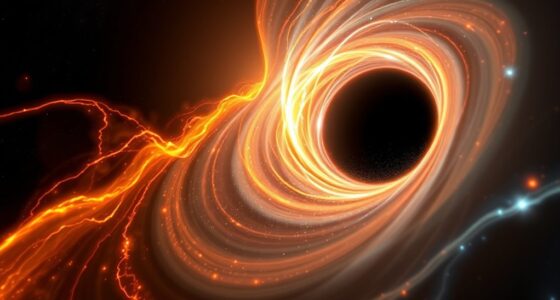Scientists have detected a persistent “cosmic hum,” a background of gravitational waves caused by countless black hole mergers across the universe. This faint signal isn’t just random noise; it’s a collective signature revealing how often black holes collide and evolve. Instruments like LIGO and Virgo pick up these tiny ripples in space-time, confirming powerful cosmic activity. If you want to uncover more about this fascinating discovery and its implications, keep exploring how it sheds light on the universe’s hidden universe.
Key Takeaways
- Scientists have detected a persistent gravitational wave background caused by numerous black hole mergers throughout the universe.
- The background acts as a cosmic soundtrack, confirming frequent black hole collisions over cosmic history.
- Detection relies on sensitive instruments like LIGO and Virgo that measure tiny space-time distortions.
- This discovery provides insights into black hole distribution, their evolution, and the universe’s early conditions.
- The finding enhances understanding of cosmic phenomena and opens new avenues for gravitational wave astronomy.

Have you ever wondered if the universe is quietly humming? Scientists have recently made a groundbreaking discovery that suggests it might be. They’ve detected a faint, persistent gravitational background—an almost imperceptible hum woven into the fabric of space-time itself. This cosmic hum isn’t random noise; it’s the telltale signature of countless black hole mergers occurring across the universe. Each time two black holes spiral into each other and merge, they release an enormous burst of energy in the form of gravitational waves. When these waves ripple through space, they create subtle vibrations that, over eons, blend into a continuous background signal. This gravitational background acts as a cosmic soundtrack, revealing the collective activity of black holes that are too distant or too faint to observe directly.
Understanding this background is akin to tuning into the universe’s radio station, where black hole mergers are the static and the faint signals that fill the station’s airwaves. It’s an extraordinary achievement because it confirms that these violent events aren’t isolated incidents but happen frequently enough to leave an audible trace in the universe’s gravitational landscape. Detecting this gravitational background requires highly sensitive instruments—like the LIGO and Virgo detectors—that can pick up the minuscule distortions caused by passing gravitational waves. When these detectors record a persistent, random signal, it points to an overlapping chorus of black hole mergers occurring over cosmic timescales. The discovery not only validates decades of theoretical predictions but also opens new avenues for exploring the universe’s history. Additionally, advancements in gravitational wave detectors are crucial for refining our understanding of this background signal and improving the sensitivity needed for future observations. Recognizing this background as a form of cosmic noise helps scientists develop better models to interpret the signals they detect.
This background gravitational wave signal provides clues about the rate and distribution of black hole mergers, helping scientists piece together how these massive objects evolve. It also offers insights into the early universe, shedding light on processes that might have influenced galaxy formation and growth. The detection of this cosmic hum further emphasizes the importance of gravitational wave astronomy as a tool for understanding fundamental cosmic phenomena. The fact that this background can be distinguished from other signals demonstrates the remarkable progress in detector technology and data analysis techniques. The detection of this cosmic hum also raises intriguing questions about the universe’s overall energy content and how different cosmic phenomena interact through space-time. As technology advances, researchers hope to refine their measurements and distinguish this background from other potential sources of gravitational waves, like neutron star collisions or exotic phenomena. In essence, this discovery confirms that the universe isn’t silent—it’s humming with the echoes of black holes colliding across the vast expanse. Listening to this gravitational background, scientists can better understand the universe’s dynamic and often violent history, revealing a deeper harmony behind its apparent chaos.
Frequently Asked Questions
How Does the Cosmic Hum Influence Our Understanding of the Universe’S Origins?
The cosmic hum helps you understand the universe’s origins by revealing the faint gravitational waves from early cosmic events. These signals provide insights into dark energy and cosmic inflation, shaping how you see the universe’s expansion and evolution. As you study these waves, you gain clues about the conditions moments after the Big Bang, deepening your understanding of how dark energy influences the universe’s growth and the inflationary period that set the stage for everything.
Can the Cosmic Hum Be Used to Detect Other Cosmic Phenomena?
You might wonder if the cosmic hum can reveal other cosmic phenomena. It’s possible, as scientists explore how gravitational waves relate to dark matter and cosmic inflation. By analyzing these waves, you could detect signals from early universe events or unseen matter. The cosmic hum offers a new way to uncover mysteries beyond black hole mergers, helping you understand the universe’s fundamental components and its rapid expansion during cosmic inflation.
What Technological Advancements Enabled the Detection of Background Gravitational Waves?
You should know that advancements in interferometer sensitivity and data analysis techniques made the detection of background gravitational waves possible. Improved interferometers, like LIGO and Virgo, can measure minuscule spacetime distortions. Enhanced data analysis techniques help filter out noise, revealing the faint signals from merging black holes. These technological progressions allow scientists to observe the universe’s subtle ripples, opening new windows into cosmic phenomena.
How Does the Cosmic Hum Compare to Other Background Cosmic Signals?
When you compare the cosmic hum to other background signals, you notice it’s a faint, persistent noise that’s different from cosmic microwave background radiation. Unlike other signals, it’s a gravitational wave background, offering insights into black hole mergers and early universe processes. This background noise is subtle, but advanced detectors help distinguish it from other cosmic signals, revealing the universe’s hidden gravitational symphony.
What Are the Implications of This Discovery for Future Gravitational Wave Research?
Imagine detecting a faint cosmic melody that’s been playing since the universe’s birth. This discovery pushes you to improve theoretical modeling and data analysis techniques, opening doors to understanding black hole populations and early universe conditions. It signals a new era for gravitational wave research, encouraging you to refine instruments and methods, ultimately revealing more about the universe’s hidden history and expanding your capacity to interpret these subtle, persistent signals.
Conclusion
This discovery isn’t just a scientific milestone; it’s a whisper from the universe reminding you that the cosmos is alive with unseen echoes. As you stand on the brink of understanding, remember—these gravitational waves are like cosmic symphonies, waiting to be heard. They’re proof that even in darkness, there’s a song, a hum, a reminder that the universe’s secrets are always within reach, if you listen closely enough.









